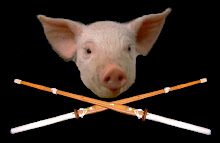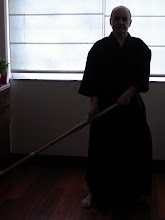Ask a martial artist who’s up on his
history to name the greatest warrior of all time, and chances are he’ll say Miyamoto Musashi, the legendary Japanese swordsman who cut down 60 men with his blade. No doubt there have been many other fighting men — both before and after Musashi’s day (1584-1645) — who killed more enemies, but undocumented knowledge seldom outlives those who possess it. What makes Musashi special is that he accumulated an incredible amount of experience and committed his wisdom to paper in the form of a timeless classic titled
Go Rin No Sho. We know it as
The Book of Five Rings.
On cursory examination, the text appears to be a simple work designed to educate young swordsmen. Yet it embodies a plethora of between-the-lines observations and advice that will enthrall anyone who reads it with a warrior’s eye. Its prose captures an old warrior’s perceptions of the world around him and conveys the lessons the master deemed essential for a young warrior’s survival. It’s important to remember that when Musashi put pen to paper, he was very old. He knew that for him, there would be no more battles and, therefore, no need to hold anything back in an effort to keep enemies from learning secret fighting methods and using them against him.
Much of the content of
The Book of Five Rings is specific to combat in old Japan, yet Musashi has plenty to teach 21st-century martial artists. We may carry a
tactical folder and a Glock instead of a wakizashi and a
katana, but fighting is fighting regardless of the year, and much of Musashi’s wisdom still applies.
His text is divided into five parts: Ground, Water, Fire, Wind and Void. A full discussion of their modern applications is beyond the scope of this article, so I’ll focus on the most poignant lessons.
Ground
“Know the smallest things and the biggest things, the shallowest and the deepest things as if they were a straight road mapped out on the ground,” Musashi wrote. His meaning is clear: Success in combat requires planning.
A lesson frequently learned early in a martial artist’s training is that those who are destined to win do so by first studying and then fighting. Those who are destined to lose tend to fight first and then study why they lost. Although no one can accurately predict the outcome of every battle and prepare specifically for it, you can certainly stack the deck in your favor.
You must develop a realistic understanding of your skills and capabilities. Study the dynamics of conflict until you possess a basic understanding of how combat unfolds. It’s crucial to approach this with a 21st-century focus since modern-day assailants don’t always use weapons that existed in ancient Japan.
Musashi compared the way of the warrior to the way of the carpenter. The carpenter plans everything with great specificity, and you, as a martial artist, should do the same — both inside and outside the
dojo. You may know exactly how you would spar with a classmate who likes to lead with a
roundhouse kick, but do you have a plan in the event of a home-invasion robbery? How about a car jacking or mugging? Being prepared means you’ll never be a deer in the headlights, frozen by the savagery of the world. Leave nothing to chance.
Water
In the second section of his treatise, Musashi wrote: “Water adopts the shape of its receptacle. It is sometimes a trickle and sometimes a wild sea. Water has a clear blue color. By the clarity, things of [my] school are shown in this book.”
One of the most difficult attributes to develop is adaptability. A wise martial artist uses techniques and tactics that fit the circumstances of the fight. His goal is to hit his adversary, not necessarily to execute his favorite technique. Knowing which kick or punch to throw as a fight begins — and being able to change course at a moment’s notice — is essential.
The ability to become a tactical chameleon requires exposure to different fighting styles. Witness the generally poor showings made by one-dimensional fighters who enter
MMA competitions such as the
Ultimate Fighting Championship. In that kind of limited-rules environment, the fighter that triumphs is the one who has trained in every conceivable method, from ground
grappling to
kickboxing and all ranges in between.
Musashi’s moral: Study everything, keep what is useful and do not limit yourself to any one system.
Fire
“This book is about fighting,” Musashi wrote. “The spirit of fire is fierce, whether the fire be small or big. And so it is with battles.”
I once saw a well-trained martial artist get his rear end handed to him by an untrained yet much fiercer street thug who had no concerns about getting beaten up or killed. That illustrated to me the importance of ferocity. Being in great shape or having trained under a renowned master is simply not enough.
Becoming a fierce fighter doesn’t mean you have to live an austere existence like Musashi did — never washing your body lest you let down your guard, never sleeping on a pad lest it make you weak and so on. It means getting your mind oriented correctly in terms of life-or-death combat. As he wrote, “The way of the warrior is the resolute acceptance of death.”
In medieval times, Japanese warriors cultivated a fatalistic approach to things. In other words, they trained to die. As a modern-day warrior, you need not seek out your own demise in the service of another, but you must make friends with the idea of sacrificing your life so that in the midst of the fight, you aren’t distracted by thoughts of self-preservation. Of course, you should endeavor to preserve your life, but you should do so with the strength that comes from having a resolute acceptance of death and the purity of focus that accompanies it.
Wind
“In strategy, you must know the ways of other schools, so I have written about various other traditions of strategy in this, the Wind Book.”
Musashi focused much of his study on the martial ways of his adversaries. He isn’t the only historical figure to have done that; commentators as geographically and culturally diverse as Carl Von Clausewitz and Sun Tzu have penned similar admonishments.
Who are the likely adversaries of the 21st-century martial artist? Gang members, criminals and terrorists, for the most part. You must learn who they are, how they operate and what they wear. In a
self-defense situation, you won’t find yourself face-to-face with a
kendo student holding a
samurai sword or with a kickboxer who announces himself and bows as though he’s part of a Hollywood fight flick. The opponent you’re most likely to confront today is a person skilled at taking you by surprise and willing to deprive you of your life without a moment’s hesitation.
“Some of the world’s strategists are concerned only with sword fencing and limit their training to flourishing the long sword and carriage of the body,” Musashi wrote. “But is dexterity alone sufficient to win? This is not the essence of the way. … In my doctrine, I dislike preconceived, narrow spirit. You must study this well.”
The lesson is obvious: Don’t be limited in your studies. If you take
taekwondo,consider adding
wing chun and
Brazilian jiu-jitsu to expand your horizons. If you focus on unarmed fighting, spend some time learning knife and gun methods. If you’re a shooter, dabble in
jeet kune do as a supplement. Remember that narrow-mindedness kills.
“Cutting down the enemy is the way of strategy, and there is no need for many refinements of it,” Musashi wrote. Nevertheless, some martial arts teachers romanticize combat. Those of us who have been there and done that know it’s a foolish thing to do. Combat has an ugliness, a reality and a finality that cut through all the dogma, doctrine, style disputes and miscellaneous clap-trap that clogs our consciousness. It’s simple, violent and animalistic. Understand it and accept it.
Void
Musashi wrote: “To attain the way of strategy as a warrior, you must study other martial arts and not deviate even a little from the way of the warrior. With your spirit settled, accumulate practice day by day, and hour by hour. Polish the twofold spirit [of] heart and mind, and sharpen the twofold gaze [of] perception and sight. When your spirit is not in the least clouded, when the clouds of bewilderment clear away, there is the true void.”
This passage typifies the Book of the Void, and throughout it, two aspects stand out: the mental, which Musashi calls “spiritual,” and the technical.
Mental: After a particularly violent gunfight, a superior asked me if I’d been scared. I said, truthfully, that I had not been. Then I qualified my answer: My lack of fear hadn’t stemmed from my being particularly brave or particularly stupid, but from being completely occupied with winning. I had trained myself to fight as well as I could, and I had a firm understanding of the rules of engagement. Additionally, I had a fall-back plan for any after-action eventuality that might crop up. Quite simply, I had a focused spirit, which is the essence of the void Musashi described.
Technical: In the November 2001 issue of Black Belt, I wrote an article titled “Enough Is Enough! The Case for Keeping Your Self-Defense Arsenal Short and Sweet.” It discussed how knowing too many techniques can be a liability because any move that’s unnatural or overly complicated will not be physically memorized. And if it’s not physically memorized, you’ll never use it in a fight.
That concept of physical memorization and subconscious programming is not new. The Japanese sword master Yagyu Tajima No Kami wrote: “Learning and knowledge are meant to be forgotten, and it is only when this is realized that you feel perfectly comfortable. The body will move as if automatically, without conscious effort on the part of the swordsman. All of the training is there, but the mind is utterly unconscious of it.”
Yagyu was referring to swordsmanship, but the concept is entirely valid for modern
combatives. Likewise, Musashi’s
Go Rin No Sho, which is more than 350 years old, remains a valid guide for the education of modern practitioners of the self-defense arts.
Gabriel Suarez is president of Suarez International Inc., a Prescott, Arizona-based training and consulting group that teaches modern combatives courses around the world.
Permalink: http://www.blackbeltmag.com/daily/martial-arts-philosophy/japanese-martial-arts/how-to-use-the-combat-concepts-of-legendary-swordsman-miyamoto-musashi-in-21st-century-self-defense/
 As melhores horas para ver a superlua
As melhores horas para ver a superlua
 Se trata de un plato estrechamente ligado a la gastronomía gallega pero, ¿Sabemos realmente de dónde procede y cuál es su origen?
Se trata de un plato estrechamente ligado a la gastronomía gallega pero, ¿Sabemos realmente de dónde procede y cuál es su origen?
